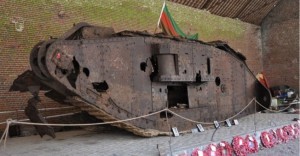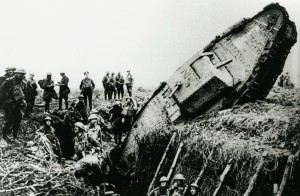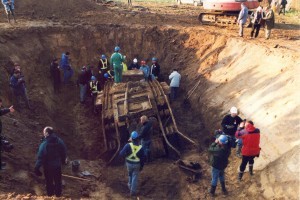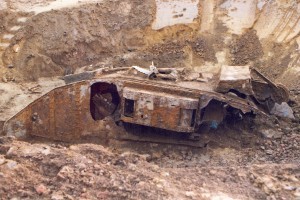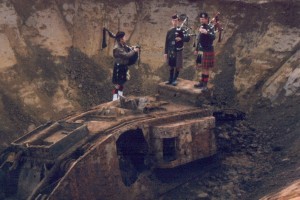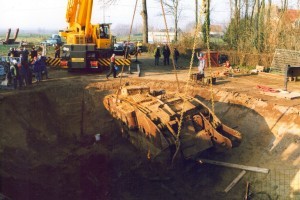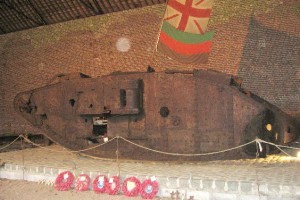A museum is set to open in the French village of Flesquières to mark the centenary of the Battle of Cambrai. The structure was specially built to house a British tank battered in battle in 1917.
She is a grande dame of 28 tonnes who answers to the sweet name of Deborah. A steel monster eight meters long and 2.5 meters high. A tank unique in France, dating back to the First World War and a listed historical monument. The new museum to house the beast is slated to open its doors in the northern French village of Flesquières on Saturday, 100 years to the week after the Battle of Cambrai began. “This centenary is really the right moment to give history its due,” explains Florence Albaret, the city of Cambrai’s director of cultural affairs. “This is one of the rare tanks to have taken part in the battle that still exists today and the only one to have been kept at the site of the fighting.”
Deborah is one of the very last direct witnesses to the Battle of Cambrai. On November 20, 1917, this British Mark IV tank – a “Female” model, equipped exclusively with machine guns – took part in an unprecedented offensive. It was the first time the British made massive use of tanks, a technology then in its infancy. At 6:20am, along a 10km-long front, 476 tanks set forth towards German frontlines. The element of surprise worked and the Tank Corps broke through. But in the village of Flesquières, where Deborah was located, German fighters were resisting with zeal. Hit by a shell, the British tank was neutralised. The tank’s carcass would rest on the spot until the end of the war, but British engineers sweeping the battlefield in 1919 wound up burying her away underground in an enormous pit.
A mere rumour
For decades, Deborah was out of sight and out of mind, forgotten beneath the surface. But in the early 1990s, Philippe Gorczynski, a resident of the region, heard a rumour. An elderly lady remembered a tank that might have been buried in the area. Intrigued, the hotel owner and Great War enthusiast took up the search. “It’s as if I had been given a treasure map,” Gorczynski says. “To begin with, the account turned out to be very interesting, but then on the ground, it turned out to be a lot more hazy because I couldn’t see a thing.” The amateur historian persevered nevertheless. He was convinced a First World War tank was out there somewhere. “I had to find it at any cost. I had already unearthed almost three tonnes’ worth of tank parts. But my goal wasn’t to make a giant puzzle, it was to find a whole one.”
After poring over hundreds of archival documents and aerial photographs, Gorczynski refined his search perimetre. In November 1998, a survey was finally conducted at the tank’s presumed resting place. Gorczynski’s hypothesis had been correct. Two weeks later, with a team from the city of Arras’s Archeology Service taking part, Deborah finally saw the light of day. To preserve her, the tank was kept in a barn Gorczynski bought in the village of Flesquières.
But he wasn’t about to end his search there. At the time, Gorczynski didn’t yet know the tank had a name. It was only by digging through the British archives that he discovered Deborah’s story. “It took me years to find the names of her crew. Of the eight soldiers assigned to this tank, five were killed. We were able to identify four. We were also able to make contact with the families,” he recounts.
‘Sculpted by war’
An association has been created since and other enthusiasts have joined its ranks. “This tank is unique because she was built by man and sculpted by war. You can still see the points of impact on her. They attest to the violence of the fighting during the Battle of Cambrai,” says Anthony Caudron, a young police officer in the Cambrai area and member of the group. “Imagine, being confined, eight of you, inside a steel box that is the priority target of German artillery. The tankers had a notion of sacrifice. They were conscious of the fact that their life expectancy in battle was shorter.”
To better raise awareness of this chapter of the First World War, Deborah finally took leave of her barn to enjoy a setting befitting of her status. Gorczynski is proud of this new step, but for the tank’s discoverer, this story isn’t over. “The final victory will be if young people continue this work of remembering. The only way to not let history fade from memory is to continue to talk about it. I am merely a ferryman for remembrance,” he says.
Source: france24.com
Ask me anything
Explore related questions
